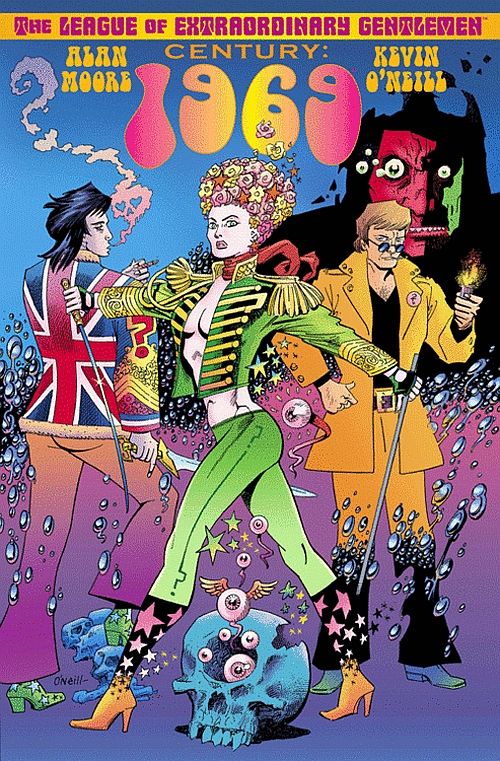After a two-year wait, the third "League of Extraordinary Gentlemen" series "Century" continues with its second book, "1969." Jumping to two years after the Summer of Love, it features Mina, Allan, and Orlando in London after rumors of Oliver Haddo's 'Moonchild' project was back in effect despite Haddo's death years previous. Like every "League of Extraordinary Gentlemen" book before it, "1969" is filled with references and allusions, fictional stand-ins for real life people, and a plot that's actually fairly straight forward.
A big part of what drives this comic is Alan Moore exploring what effect immortality is having on Mina and Allan. Allan seems to have little problems with it, while Mina is constantly struggling with the idea that she was once a repressed Victorian woman and now finds herself in the middle a free love drugged out culture. Each of these books is treated like its own little event, and Moore's smart to make sure that there's a strong serialized character-driven element. The book can stand on its own, but marveling at how far Mina is willing to go and change while maintaining her sanity is part of the fun.
The simple plot picks up from the first "Century" book with Oliver Haddo's quest to create an antichrist 'Moonchild' still in full swing, albeit sidelined by his quest to find a suitable, lasting body. He finds a suitable host in the form of Terner, a Mick Jagger stand-in inspired by his role in "Peformance," and works to make the transition at a tribute concert for Brian Jo... er, Basil Thomas. The disparity between what the League think Haddo's followers are up to and what's going on is entertaining, reminding us that the League is usually a few steps behind.
The sheer amount of references is a little overwhelming. Thankfully, most are relegated to visual cameos that don't necessarily add or detract from your enjoyment. It's simply enough to know that most of the characters that populate London are probably taken from the fiction of the time, a lot of whom were thrown in by artist Kevin O'Neill. The bigger allusions are more critical and lead to some fun realizations. One of the most entertaining parts of the comic is Moore's rewriting of "Sympathy for the Devil" for this fictional version of the Rolling Stones.
So much of the comic relies on O'Neill's ability to pull off visual allusions and fill the space. His overblown style is perfectly suited to pages crammed with references and as much information an artist could fit into a panel, working almost as a pop culture version of George Perez's superhero comics. In the process, O'Neill never loses sight of the focus of panels and pages, making sure that crowd characters remain the crowd and don't detract from the storytelling.
The way he defines the look of this 1969 London is a remarkable combination of styles from the time and the influence of this fictional reality. In a few scenes, women are seen in clothing that look based on superhero fashion. A lot of the time, the look is from the time but made even more over-the-top and in your face. It's a four-color bright world with some seedy underbelly parts.
Part fun fiction exercise, part straight up adventure story, "The League of Extraordinary Gentlemen: Century: 1969" is a flat-out fun book to read. Underneath all of the references and allusions is a very easy-to-follow story that has all of that other stuff built up all around it. If you don't know who people are, it still works, and that extra knowledge is a rewarding bonus for those in the know, or who have read Jesse Nevins' annotations. As well, the ending is a perfect cliffhanger that makes the final volume in the story, "2009," seem much too far away.

